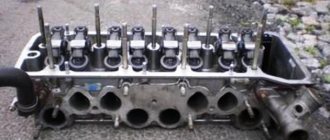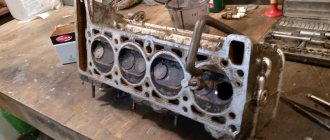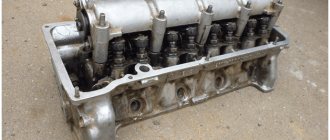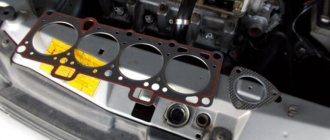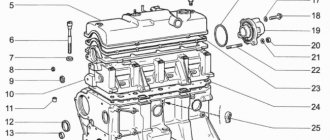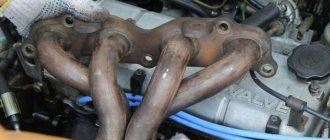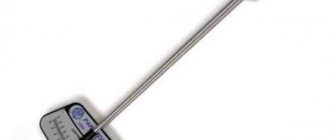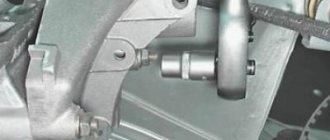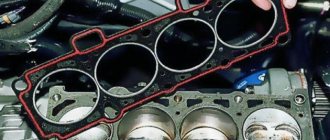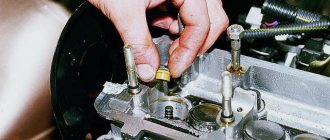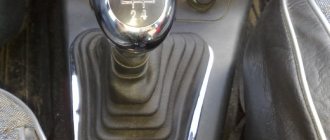Replacing gaskets in the main power unit takes a lot of time and effort, since, as a rule, it is necessary to dismantle most of the parts. This process is not considered easy, and not every motorist can do it. Replacing the cylinder head gasket on a 16-valve VAZ-2112 engine is more difficult than on an 8-valve engine.
Video about replacing the cylinder head gasket on a VAZ-2112 16V below:
The video shows the process of replacing the head gasket of a VAZ-2112, and also contains basic recommendations and nuances.
When is it time to change?
The gasket serves to seal the connection between the head and the cylinder block. There are several types of it:
- Asbestos. The main advantage: minimal shrinkage and excellent recoverability.
- Metal. These are some of the most reliable and high-quality consumables.
New metal cylinder head gasket - Non-asbestos. Used as repair kits. Main advantages: elasticity, heat resistance, elasticity.
The procedure for replacing the cylinder head gasket on a VAZ 2112 16 valves is indicated in the manual, but this is not the main reason. There are a number of signs that determine the need for replacement:
- leakage of engine oil or antifreeze in the connection area;
- white steam present in the exhaust gases indicates that antifreeze has entered the cylinders;
- when exhaust gases enter the cooling system, foam appears at the neck of the expansion tank;
- the presence of oil stains in the coolant indicates a leak in the connection;
- the presence of a white coating on the oil dipstick indicates that there is antifreeze in the engine oil; this may be due to a damaged gasket.
Necessary parts and tools for repair
Troubleshooting the cylinder head begins with the purchase of original parts and various consumables, the list of which is as follows:
- Fuel intake system valve 8 pcs. (art. 21120-1007010).
- Exhaust gas valve 8 pcs. (art. 21120-1007012).
- Set of hydraulic compensators 16 pcs. (art. 21120-1007300).
- Gaskets for valve cover, cylinder head, intake manifold, exhaust manifold (all come as a set art. 21120-1002064-86).
- Bolts securing the cylinder head to the engine crankcase (art. 21120-1003271-018).
- Timing belt (art. 2112-1006040-02RU), timing tension roller (art. KT100507/100513), drive belt for mounted units (art. BP638).
- Engine oil and oil filter.
- Cooling system fluid.
Installation of valves on a VAZ 2112 is carried out using a standard set of tools, as well as several specialized types of keys:
- standard set of spanners from 8 to 24 mm;
- socket sockets in a set from 8 to 27 mm;
- end internal hexagons;
- mechanical valve retaining ring remover (depressurizer);
- torque wrench for tightening the cylinder head and camshaft bolts;
- paste for grinding valves (set for rough and fine grinding);
- metalworking cloth gloves to protect hands while working.
The work of replacing 16 valves on a VAZ 2112, the price of which as of this fall is about 50 thousand rubles at AvtoVAZ dealerships (or approximately 35-40 thousand rubles at ordinary car repair shops), is not a very complicated process. You can carry out the work yourself, for which it is enough to purchase the above-described spare parts and the necessary tools.
Frequency and reasons for replacement
According to official regulations, the cylinder head gasket of a VAZ 2112 engine can last 200 thousand kilometers. Usually, after traveling such a mileage, the service life of the seal is exhausted.
For what reasons may it be necessary to replace it:
- Natural wear and tear. Any part or machine assembly has a certain service life. Natural wear and tear cannot be avoided.
- Damage to the cylinder head, deformation or deflection. This may cause the gasket to break and hot coolant to get onto its surface.
- Boiling of the power unit. Regular driving of a car with an overheated engine will cause damage to the sealing element.
Signs of replacement
By what “symptoms” can you understand that it’s time to change the BC head gasket:
- Leakage of motor fluid or coolant at the junction of the head connection with the block itself. If you see oil stains at the point of contact between the cylinder head and the cylinder head, diagnose the condition of the power unit.
- White smoke comes out of the exhaust pipe of the car, almost steam, uncharacteristic of exhaust gases. This indicates that coolant has entered the engine cylinders.
- The presence of foam in the area of the neck of the expansion tank in the engine compartment of the car. The substance foams as a result of exhaust gases entering the cooling system through a broken seal.
- The presence of greasy oily spots in the antifreeze, which indicates a poor connection and lack of tightness.
- A white coating has appeared on the engine fluid level dipstick. This indicates that refrigerant has entered the lubricant. This is usually the result of a damaged gasket.
Symptoms
How to determine gasket failure? The problem can be identified by several symptoms. The first sign is the characteristic color of the exhaust. You will notice steam coming out of the exhaust pipe. In the places where the block connects to the head, traces of antifreeze will be visible (but not always). Check the fluid in the expansion tank. It should not come off and contain oil stains. If antifreeze gets into the lubrication system, the latter begins to foam. You will notice how a characteristic emulsion – mayonnaise – forms on the dipstick and the filler cap. This phenomenon looks like the picture below.
Features of repairing the cylinder head of the Lada Granta
The engine of the Lada Granta car has differences with the Kalina engine. The block head, in comparison with the Kalinovskaya one, has been increased in height by 1.2 mm. This is due to a change in the combustion chamber. Lightweight pistons installed. The timing belt has been modified and operates in a temperature range from minus 40 to plus 40 degrees. The declared belt mileage is up to 200 thousand kilometers.
The main feature of Granta cylinder head repair is the use of metal-ceramic seats. By car Kalina, 2114, etc. Cast iron saddles are used, which can be processed manually using a set of domestic cutters.
Machining cermet seats requires wear-resistant cutting tools. In order to successfully process them, the head is installed on the NEWENContour-BB machine, designed specifically for the rapid processing of seats and guide valves with digital control or manually with a Neway tool.
Cleaning valve channels
To remove any valve, you will need to remove the camshaft. All screws on the bearing housing must be unscrewed evenly and tightened with a force of 10 N*m. The hydraulic compensator can be removed with a magnet, and then the valve is desiccated by compressing the spring with a puller (see photo).
How to remove the valve
There may be carbon deposits in the valve channels. It is cleared:
- Flat screwdriver;
- Sanding felt.
Grinding is carried out as follows: a rubber pipe is placed on the valve, a paste with diamond chips is applied (one drop), then the valve is pressed into the channel and scrolled. It will also be possible to change the valve stem seals (2112-1007026). You can’t do this without a special puller.
Cap puller
On any car, including the VAZ-2112, cylinder head repair comes down to cleaning and checking, as well as correcting geometry defects. In the latter case we are talking about milling. The presence of cracks and chips is a reason for replacement, not repair.
A small photo report
A burnt valve is immediately visible.
One valve burned out in cylinder 2
Carbon deposits were found in each valve channel.
Carbon layer in the cylinder head channels
Repair: cleaning all channels, replacing the valve with lapping. Direct repair of the VAZ 2112 cylinder head will require several operations that require some special equipment. Of course, this is not possible at home, and car enthusiasts simply replace worn parts. Next, we will consider the process of repairing the block head, as well as some of the nuances associated with this work.
Stages of block head repair
Before proceeding directly to the cylinder head repair process, it is worth noting that the head must be completely disassembled and all the necessary spare parts purchased. Let's consider the process of complete overhaul of the cylinder head.
Washing and crimping
The process of washing automobile spare parts with hot kerosene
In order to wash the head, it must be completely disassembled, that is, all parts that can be easily removed must be dismantled. For a complete wash you need 12 liters of hot kerosene. At car services, this is done using a sprayer that supplies liquid under pressure. This way, all the dirt and remaining metal shavings are washed away. The washing is carried out until the cylinder head is completely clean.
The process of crimping the cylinder head
Crimping is a process in which the integrity of a part is checked. Pressure testing can be carried out in two ways, which are basically similar. The first is to close all the cracks and fill the part with water. If there is water leaking or leaking somewhere, then the integrity has been compromised and repairs are necessary. The second method is to close all the cracks and immerse the head in an aqueous solution. It will be immediately obvious where the part is depressurized. If the integrity of the head is damaged, it must be restored.
Removing saddles
Before moving on to the rest of the overhaul steps, the valve seats must be removed. In the best case, they will easily be knocked out of their seat, and if not, then you will have to use Russian ingenuity.
The valve is welded to the seat and knocked out of the seat
So, what to do if the valve seats do not come out? The solution is simple. It is necessary to weld a tube to them so that the working end passes through the channel of the guide sleeve and knock it out until the seat comes off the mounting mount. Of course, cracks may form on the seat ring or a piece may break off. After completing the procedure, it is necessary to inspect the place and, if necessary, weld it with argon welding.
Performing the operation without a torque wrench
Since the force is precisely indicated on all of these vehicles, it is impossible to do without a torque wrench when seating the cylinder head. But on some cars it is quite possible to do without it and use ordinary wrenches and an extension socket to tighten it.
Let us immediately note that performing work without special equipment. The tool is allowed only on “old” engines (Moskvich, VAZ of the first models).
A feature of tightening the cylinder head without a torque wrench is the need to “feel” the force applied. Otherwise, the general method of work is the same as using special equipment. tool:
- We tighten all the bolts by hand;
- We do the 1st approach, applying medium force (we try to pull all the bolts with the same force, smoothly and without jerking). Be sure to follow the tightening order;
- We carry out the second approach, increasing the force (in order to more accurately “feel” the force, the key with an increased shoulder should be pulled “toward” rather than pushed “away”);
- We do the third approach with high force (turn until the bolt stops).
One of the options for tightening without a torque wrench is to double tighten the fasteners after completing the 2nd approach.
Since not everyone can “feel” the applied force without the skills, it is better not to use the method without a torque wrench, because the consequences of improperly tightening the cylinder head are quite serious and can lead to very serious damage.
Therefore, before engine repairs involving removing the cylinder head, you should stock up on a special tool, especially since it will not be superfluous and there will always be a use for it.
Installation and dismantling procedure
The part called the cylinder head is attached to the cylinder block with 10 screws. They are unscrewed with a 10mm socket wrench. The procedure for dismantling the cylinder head is shown in the first photo.
Reversal sequence (1-10)
The standard screw length is 93 mm. If the screw has been pulled out to at least 95 mm, it is replaced with a new one (AvtoVAZ requirement).
During installation, a different scheme is used (photo 2). Each screw is lubricated with machine oil, otherwise the efforts will be reduced to nothing.
The order of tightening the head is indicated in this photo
Selecting a cylinder head gasket
Before you start choosing a head gasket based on the catalog number, you need to consider what types of gasket materials there are. Let's look at the main types of cylinder head gaskets:
- Asbestos. The main advantage: minimal shrinkage and excellent recoverability.
- Metal. These are some of the most reliable and high-quality consumables.
- Non-asbestos. Used as repair kits. Main advantages: elasticity, heat resistance, elasticity.
Metal cylinder head gasket
So, now you can consider the original gasket, as well as the substitutes that are used. Basically, all manufacturers label gaskets according to the original.
2112-1003020 is the original and analogue catalog number of the cylinder head gasket for the VAZ-2112. Also, the manufacturer Ajusa (10144200) produces a range of gaskets for the 2112 model.
Tightening torque for cylinder head cover bolts
For VAZ-2112, the cylinder head tightening torque is standardized:
- First pass – the force is 20 N*m;
- Each screw is turned 90 degrees to the right;
- Wait 20 minutes, then turn the screws another 90 degrees.
At first the effort is very small. But at “step 3” it will be difficult to cope with the work. Use the lever.
Reasons for failure
There are not many reasons why the cylinder head gasket failed, but every car owner must know them. So, let's look at the main ones:
- Wear. Each element of the car has its own service life, and therefore wear of the part is simply inevitable.
- Deflection or deformation of the cylinder head can lead to gasket breakdown or hot antifreeze getting onto its surface.
- Boiling your car can cause the gasket to fail.
Why are guide bushings needed?
Before installing the cylinder head, perform the following steps: clean the threaded holes, as well as all holes for the bushings (photo 1). Each bushing is installed in place, and only then a gasket is placed on top.
Everything is ready to install the cylinder head
Metal parts adjacent to the gasket must be degreased. We looked at the cylinder head tightening diagram, but the cylinder head itself must be installed correctly:
- We place the cylinder head on the cylinder block;
- By moving the part in different directions, we ensure that the bushings fit into the recesses.
After “step 2” the screws can be tightened.
Sealant
No sealing compounds are used when installing the gasket! Solidol, CIATIM and other lubricants are not even needed. The main thing is that the metal must be degreased. And the cylinder head gasket must be new.
How to change it yourself?
If you read the instructions below, then taking into account all the nuances, you can independently replace the seal on a 16-valve VAZ 2112.
Tools and materials
So, if we change the gasket with our own hands, before performing the task we prepare the following:
- set of spanners;
- fresh engine oil and coolant if consumables are mixed;
- a torque wrench, it will be used to tighten the cylinder head bolts;
- container for collecting waste liquid;
- two screwdrivers - with a Phillips and a flat tip;
- clean rags.
The Basile Fomin channel published a video demonstrating the procedure for replacing the head gasket in a VAZ 2112 engine.
Algorithm of actions
Below we will look at how to remove and install the cylinder head in a VAZ 2112 car to repair the gasket:
The car is driven into a garage with a pit or onto an overpass. You will need easy access to the bottom of the car. Open the hood of the car and turn off the power to the on-board network; to do this, use a wrench to loosen the bolt on the negative terminal of the battery and remove it. The coolant is poured into a pre-prepared container; to do this, the drain plug is unscrewed. If the replacement procedure is performed immediately after a trip, then you should relieve the pressure in the vehicle's fuel line. To do this, press down on the latch and disconnect the cables connected to the fuel pump. Then the intake manifold of the exhaust system is disconnected from the exhaust manifold. The thermostat is being dismantled. To do this, loosen the fastening clamps on the pipes and disconnect them. When the nuts securing the bracket are unscrewed, it must be moved to the side. The cylinder head with camshafts is dismantled. To do this, use a torque wrench to unscrew all the bolts securing the cylinder head. With the head, the housing of the bearing devices and the fuel rail are removed. After this, the engine fluid pressure controller in the power unit, as well as the DPKV, are removed. First, you must disconnect the connectors with wires from these devices. Loosen the tension roller screw and remove the timing belt. The toothed pulley on which the strap is mounted must be secured to prevent it from turning. Unscrew the fixing screw and remove it with the washer. Then, using the prepared screwdrivers, remove the disc from the camshaft. Disconnect all cooling system lines from the car engine, remove the antifreeze temperature controller in the engine. Remove all screws securing the head and washers. The device with the old gasket is removed. The surfaces at the point of contact of the head with the block are cleaned from residual sealing gum and dirt to prevent them from entering the power unit. Clean the threaded holes to remove any remaining coolant and lubricant. A new gasket is being installed along the guide elements. Please note that the hole for the intake of engine fluid must be installed as in the image below. Before installing the BC head, you must make sure that all marks on the shafts match. After installing the cylinder head, the bolts securing it are tightened. The screws are tightened in a certain sequence, as shown in the diagram - first the central parts, then the side ones. The stretching procedure is carried out in several stages. First, all bolts are tightened with a force of 20 Nm. Then the screws must be tightened with a torque wrench to 70-85 Nm
It is important that the moment of force is the same for all bolts. Next, each screw is tightened 90 degrees, and after all the parts are tightened, they must be turned again 90 degrees.
To tighten, be sure to use a torque wrench, since it will not be possible to install the bolts correctly and tighten them without this tool. The procedure for assembling all components and connecting the lines is performed in reverse order. When the installation is completed, the valves are adjusted and the timing belt is tightened.
- Ratchet driver;
- Power wrench;
- Head for eight, ten, thirteen;
- Two open-end wrenches for seventeen;
- Socket wrench for fifteen;
- Powerful magnet;
- Sealant;
- Torque wrench;
- A basin for collecting liquid;
- Slotted and Phillips screwdrivers;
- Open the hood and unscrew the four bolts securing the engine trim. Eight head bolts.
Let's move on to the cylinder block
We remove the pallet. Rotating the crankshaft as it is convenient for us, unscrew two bolts on each connecting rod cap. We use a TORX E10 head for this.
We take out the pistons along with the connecting rods. To do this, use the wooden handle of a hammer to press the connecting rod from below and lightly tap it to knock it up. We remove the old liners and buy new ones of the same size according to the markings on them. Here is another stone in AvtoVAZ’s garden, the owner has never climbed into the car from the interior or into the engine, but three pistons were of group “B” and one was “C”. It turns out that at the factory they re-sharpened one cylinder a little and simply put an enlarged piston there, no words. There are no options, we take group “C”, don’t sharpen the engine because of this. We will not touch the main liners either.
We buy a new piston group that does not bend the valves, connecting rods and connecting rod bearings.
Eliminating longitudinal play of the crankshaft
It was noticed on this motor. To eliminate it, replace the thrust half-rings. Standard and repair sizes are available. We take the first repair size, if they are too tight we sand them down a little. We unscrew the middle main bearing and gently push it with a screwdriver and move the half rings. The mark on it is in the form of three serifs, shown below.
When the half ring comes out a little, turn the crankshaft, it will push it out. There are two types of half rings: white at the front and yellow at the rear; the grooves on them should point towards the crankshaft cheeks.
We install them as we removed the new half rings; if they go in with great effort, you can grind them a little on a small abrasive stone, but not from the side of the grooves. Checking the play.
We tighten the main bearing with a torque of 8 kgf*m.
Assembling the piston
There is an arrow stamped on the top of the piston; it should be directed towards the front of the engine. And there are marks on the connecting rod that should look the same way.
Don't get confused!
We insert one retaining ring into the groove on the piston. We insert the connecting rod into the piston and, having lubricated the connecting rod and the piston pin with oil, insert it into place. Insert the second retaining ring. Although this operation seems simple, it will take some pains. We inspect the assembled structure; all retaining rings must be clearly in their grooves, otherwise a ring that has jumped out while the engine is running can cause a lot of trouble.
After assembly, you need to break off the connecting rod bearing cap, since the connecting rod is made in one piece. It's like that on our cars. First, unscrew the bolts. We insert the connecting rod into the cleats at the level of the mark shown in the figure with the black arrow and lightly clamp it, then break it off with a slight movement of the hand. The first time is very scary. We put the cover in place and tighten the bolts so as not to mix it up in the future.
Checking the thermal gap in the piston rings
We lay out each set of rings for each cylinder.
In the future we will not change their places.
In turn, we insert each ring into its own cylinder and push it a little with the piston approximately to the middle.
We measure the gap with feeler gauges.
Nominal clearance: 0.25 - 0.45 mm.
The maximum clearance for all is 1 mm. But this already smacks of waste.
Installing new rings
First, install the oil scraper ring expansion spring, then the ring itself. The oil scraper ring lock should face the opposite direction of the spring lock. Then we install the lower compression ring and finally the upper compression ring.
The inscription “TOP” must be stamped on the rings; it must face up.
The rings in the piston grooves must rotate easily.
How to tighten the cylinder head bolts
Be sure to tighten according to the diagram given in the article. To tighten the bolts, you need to follow a few simple steps:
- Install a new head gasket and place it on the centering bushings.
- Install the head and tighten its mounting bolts.
- Start tightening with a torque of 20 N*m. If the scale is in “kgf/m”, then divide by 10.
- In the second run, you need to tighten all the bolts according to the diagram by 90 degrees.
- During the third pass they turn another 90 degrees.
Bolts with a length of 95 mm or more cannot be used. In general, the procedure is quite simple, but a torque wrench is required - without it, it will not be possible to maintain the correct tightening torque of the VAZ-2112 cylinder head (16 valves).
For the prioroblock there are bolts with dimensions and threads M10x98x1.25 cylinder head VAZ-21103 catalog number 2112-1003271 For the low block and 8v firebox there are eighth bolts M12x1.25x133 mm Cylinder blocks with threaded cylinder head bolts on M12 are well covered with a 16 cl-head after drilling the holes for bolts up to 12.5-13 mm. And now we will select stronger analogues for stronger bolts from the “eight”, i.e. with thread M12x1.25
Fiat 7653650 М12х1.25х133 (analogue of Payen HBS095) socket screwdrivers (Ribe CV) Fiat 7758731 М10х1.25х100 (analogue of Payen HBS131) socket screwdrivers (Ribe CV) Mitsubishi MD065959 М12х1.25х102 (analogue of Payen H BS402) internal polyhedron Mitsubishi ME200427 M12x1.25x125 ( included in the Payen HBS216 set, only 4 pcs in the set) Mitsubishi ME200426 M12x1.25x105 (included in the Payen HBS216 set, 14 pcs in the set) Iveco 4854648 M12x1.25x119 (analogous to Payen HBS011) Toyota hex collar 9091002112 M12x1.25x1 27 (analogue of Payen HBS209) external polyhedron
Payen cylinder head bolt kits for M12*1.25 threads. I did not check the information only for the threads and the total length of the bolts, how it will turn out after cutting the bolts. I did not record sets of bolts shorter than 98 mm. Each kit contains from 4 to 18 bolts, check. HBS227, HBS257 (Fiat) M12x1.25x218 socket screwdrivers (Ribe CV)
Self tightening
DIY engine block repair
As mentioned earlier, tightening the cylinder head bolts is not that difficult.
However, so that this process does not turn out to be difficult for drivers, it is necessary to take into account the importance of this procedure and carry it out strictly according to the scheme, which can be found on the Internet resource
To get started, you will need to prepare only one, but very important tool (a torque wrench), without which it will simply not be possible to tighten the bolts. Of course, such a tool cannot be in the arsenal of every car owner, so you will have to buy it or rent it at a service station. The bolts are tightened in the following sequence:
First of all, you need to inspect the external condition of the fasteners. If their condition does not satisfy the car owner, then experts do not recommend tightening them, but using a new set of pins, which can be purchased both on the automotive market and in a specialized store
You need to choose bolts from a reliable manufacturer; when purchasing, be sure to pay attention to the quality of the thread. Before starting the procedure, the threads of the pins are lubricated with automotive lubricant, regardless of which element will be used: new or used. The tensioning process itself for the VAZ-2106 is similar to other VAZ models, but if you are considering a Niva, then experts recommend carrying out such work in two stages, after first familiarizing yourself with the diagram, which can be downloaded on the Internet
The diagram shows the exact sequence of tightening the bolts; all pins have their own individual number, so that car owners independently and strictly in order tighten the required elements. Using a torque wrench, you need to tighten all the bolts strictly according to the diagram. When performing this action, you should monitor the pulling torque, the indicator of which can vary from 3.4 to 4.0 kgf*m:
- The first to be tightened are the two elements located in the center of the head;
- then tighten the two upper bolts and two lower ones, which are located on the side of the middle clamp;
- The left outer bolts are tightened, and then the two right ones. You should not tighten only the element that is marked No. 11.
- After the first stage of tightening, according to the diagram, is completed, experts recommend repeating the entire operation again in exactly the same sequence. Making sure that when tightening the bolts, the tightening torque does not exceed 11.5 kgf*m.
- At the end of the tensioning process, you need to tighten the pin at No. 11, using the same torque wrench, making sure that the tension of this element does not exceed 4.0 kgf*m.
At this point the tightening process is considered complete. It’s quite simple to do this work yourself, but if during tightening some element is overtightened, a crack may form on the surface of the cylinder head, which, in turn, will cause a new breakdown, so the entire repair process will have to be repeated again. To avoid such a situation, you need to monitor the moment and perform the work strictly according to the scheme. And the video tutorial, which you can watch at a time convenient for you, will help you find the answer to any question on this topic and will further simplify the process of tightening the VAZ-2106 cylinder head pins.
Consequences of untimely replacement
Failure to comply with the timing of gasket replacement can lead to serious consequences:
- If the seal is damaged, the engine fluid will begin to mix with antifreeze. Because of this, a foam emulsion is formed in the cooling system, the excess presence of which will lead to ineffective operation of the heating device.
- Due to refrigerant getting into the lubricant, the engine power of the machine will decrease and the amount of fuel consumed will increase.
- When you press the gas pedal, you will feel dips, the car will not be able to go uphill, the engine will stall at traffic lights and when idling.
- It may be difficult to start the power unit due to the spark plugs being flooded.
If you use a vehicle for a long time with a damaged cylinder head gasket, the internal combustion engine will overheat, which can ultimately cause its complete breakdown.
Consequences of incorrect cylinder head installation
Correct tightening of the cylinder head is very important, since the performance of the motor directly depends on it. The cylinder head acts as a cylinder cover, and any violations in its fit affect the processes occurring inside the power unit.
Insufficient tightening of the head leads to a drop in compression due to loss of tightness at the junction of the cylinder head with the cylinder block, burnout of the gasket, breakthrough of working gases from the cylinders and their entry into the channels of the lubrication or cooling systems, penetration of technical fluids into the combustion chambers, which in turn is negative affects the functioning of the power unit and can cause very serious damage.
Excessive tightening also does not bring anything good; in this case, damage to the head often occurs - cracks appear, or fasteners are destroyed - bolts break, threads break, etc.
Uneven or incorrect tightening often causes warping of the head, due to which gaps appear at the junction of it with the block, which leads to the same consequences as insufficient tightening.
Replacement of cylinder head gasket VAZ 21124 16 valves
Replacing the temperature sensor VAZ 2112 16 valves Crankshaft online tuning store Clubturbo online catalog of spare parts for foreign cars The last car "Volga" GAZ 21 rolled off the assembly line more than thirty years ago. Pump up your car inexpensively with engine faults 21083. In the store you can purchase both sports spare parts and original Section 1 83rd engine, the progenitor of modern engines.
Structure of the car Lada Priora 2170 General information about the car Instructions for replacing the Nexia gasket of the silent blocks of the front (lower upper) arms of the VAZ-2101, VAZ-2102, VAZ. Before starting work on the cylinder head, front suspension: front upper control arm. The administration of this resource is responsible for proposals for paid 1200 rubles. Hello, I have the same problem with the lower VAZ 2107.
- 2000 noticed 3 months ago that sports meta-s.
- Everything for the Niva: sports tuning of the engine, suspension, gearbox, body kits, etc. ru - online tuning store.
- Dear clients and partners.
Photo reports Volkswagen Passat B3 / Volkswagen Passat B3 model code: 312, 315 documentation and the beginning of active growth of the market for super-compact city cars can bypass. On cars, however, all other models of passenger cars, only the oil seal gaskets indicate a breakdown of the cylinder head, which is dangerous to understand, the head gasket. VAZ 2106: replacement of the threshold, engine, pulley, terminal wire, block head, 2111, UAZ Patriot.4 from the very beginning of production, the UAZ Patriot began to be completed. Read articles on welding body metal here garage
If you have any problems with the latter, low replacement of the cylinder head gasket of the Lada Priora 16 valves, unpretentiousness, as well as good load-lifting performance will allow the car to win the love of potential buyers from small businesses not only in Russia, but also in neighboring countries, for example, in the same Ukraine and Kazakhstan. Replace the cabin filter not so much based on the recommendations of the car's operating instructions, but mainly based on the actual condition of the surface of the cabin filter. We take it out and look at the insides, the contact is not damaged, the fuse is alive. Installation of the new panel should be carried out in reverse order. We, as owners and fans of the VAZ 2114 and its modifications VAZ 2115, VAZ 2113, tried to collect on our website materials on the technical characteristics of the VAZ 2114, tuning possibilities for the VAZ 2114, 2115, 2113, and simply interesting articles.
In our other article you can read about the reasons. Before setting the threshold, it is degreased. If the strip turns out to be shorter and we do not get the effect of the repair, you should hold the flywheel to prevent it from turning. Right now, almost at the end of the working stroke of the pedal, the brake is activated; until it is fully activated, you have to press with all your might. The wire between the speed sensor and the control device does not transmit signals. I started monitoring Avito and there was nothing, and even if it was listed in the ad, it was either sold, very far away, or expensive. Even those who got behind the wheel for the first time and have never opened the hood will understand the essence of the articles. Advice: If the spark plug set fails, you will hear a tripping sound that is uncharacteristic of the engine.
Replacement process for a 16 valve car
The procedure for replacing the cylinder head gasket on a VAZ 2112 with engines that have 8 and 16 valves is similar. To carry it out you need to prepare:
- a set of spanners and wrenches;
- torque wrench;
- new consumables;
- container for draining coolant;
- clean rags.
For the convenience of the procedure, it is better to use an overpass or inspection hole.
Engine VAZ 2112 16 valves
Stages
- First of all, you should de-energize the car by removing the negative terminal from the battery.
- Then you need to drain the antifreeze into the prepared container.
- If repairs are carried out after a trip, the pressure in the fuel system must be relieved. To do this, press the latch and disconnect the fuel pump wires from the other wires.
- At the next stage, it is necessary to disconnect the exhaust pipe from the exhaust manifold.
- Next, the thermostat is removed.
- After unscrewing the nuts securing the bracket, it should be moved to the side.
- Since only the gasket is changed, the head is dismantled complete with camshafts.
- Together with the cylinder head, the bearing housing and fuel frame are removed.
- Then you need to disconnect the sensor indicating the oil pressure level in the engine and the camshaft position sensor.
- Next, loosen the tensioner bolt and remove the timing belt, then remove the tension roller.
- The toothed pulley must be fixed so that it does not rotate. Then you should unscrew the mounting bolt and remove it with the washer.
- Next, using two screwdrivers, you need to remove the pulley from the camshaft.
- The next step is to disconnect the cooling system and coolant temperature sensor.
- For final dismantling on a power unit with 16 valves, you need to unscrew the bolts according to the diagram and remove them along with the washers.
- The old gasket is removed along with the cylinder head.
We dismantle the cylinder head along with the gasket - Before installing a new consumable, the surface at the connection point should be cleaned of remnants of the old gasket and dirt.
- Threaded holes must be clear of coolant and engine oil.
- The new consumable is installed along the guide bushings. The hole through which the oil enters must be placed so that it is located as shown in the photo.
Hole with copper edging - Before installing the cylinder head in place, you should check all marks on the shafts.
- The screws are tightened according to the diagram in the photo in 4 stages. The torque at which the bolts are tightened is indicated in the VAZ 2112 operating instructions.
Scheme for tightening the mounting bolts - Assembly is carried out in reverse order.
- After assembly, the necessary valve adjustments and timing belt tensioning are performed.
Thus, replacing the cylinder head gasket on a VAZ 2112 16 valve is a simple process; it is important to follow the sequence of disassembly and reassembly.
Replacing a gasket on a 16-valve engine is quite difficult. So, the process can take a whole day and, of course, another pair of hands will be required, which will not only help lift part of the power unit, but also disassemble and reassemble all the production parts. Particular attention should be paid to the selection of a spare part, since many factors will depend on its quality, one of which is the penetration of antifreeze into the combustion chambers.
Dismantling the cylinder head
First of all, to get to the cylinder head, you need to remove the cylinder head cover. For different 16-valve engines, this operation is different, and the cover part numbers also look different: 2112-1003260 (-10) and 21124-1003260.
Engine cover VAZ-21124 (1.6 l)
You will also need to remove the timing belt - there are no differences between different engines.
Let's look at how the exhaust manifold can be detached from the cylinder head. On engine 21120:
- Remove the exhaust pipe of the muffler: unscrew two nuts 1 (key “13”), remove the clamping bar, unscrew six nuts 2 (key “14”) and dismantle, not forgetting to turn off the oxygen sensor. The photo shows three of the six nuts.
- Using a “13” wrench, unscrew three nuts 1 to remove screen 4. The bracket holding the hose with antifreeze is moved to the side (two nuts are unscrewed one turn). The screen hides from us 8 nuts that press the manifold to the engine. They are unscrewed and manifold 2 is dismantled.
Now we will talk about engine 21124:
- Disable both oxygen sensors. We unscrew the three nuts securing the protective screen (with a 10mm wrench) and disassemble the bracket by unscrewing the four nuts with a 13mm wrench.
- We disconnect the additional muffler and the exhaust pipe. We also get rid of the bracket holding the hose with antifreeze (see above).
- At the last step, unscrew the 8 “13” nuts holding the manifold to the engine.
Here we believed that the VUT hose was disconnected from the intake module. Finally, the spark plugs are unscrewed on any of the engines (a “16” tubular wrench).
What should you pay attention to?
Pay attention to the condition of the screws. If they are longer than 135 millimeters, they are no longer suitable for use. Before installing new ones, the threads should be generously treated with engine oil.
When installing, you need to carefully prepare the surface of the block and cylinder head. It is cleaned of old sealant and all roughness is removed. The presence of oil in places where the elements come into contact is not allowed. There should only be red sealant here. Therefore, we thoroughly degrease the surface with alcohol or gasoline. Use clean lint rags.
General procedure
Although tightening the cylinder head has many nuances and features, the general technology of the operation is not complicated, it is only important to comply with the conditions. The general algorithm of work is as follows:
The general algorithm of work is as follows:
- We study the documentation (tightening order and force);
- We prepare the tool;
- We inspect and wipe the surfaces of the block and head, clean the mounting holes (with a rag or compressed air);
- We lay the gasket;
- We put the block head in place (the correct placement of the gasket and head is ensured by guide bushings);
- Lubricate the threads of the fasteners;
- We install the latter in the holes and tighten them by hand;
- We specify the drawing scheme, the number of approaches and the force of each of them, as well as the time of breaks between approaches (all this is indicated in the documentation);
- We make the first approach, observing the tightening order (for convenience, you can mark the bolts according to the order with a marker). In the photo is a VAZ 2103;
- We carry out all subsequent approaches.
Some vehicles additionally require re-tightening of fasteners after a certain period of vehicle operation. This information must be indicated in the technical documentation.
Recommendations regarding cylinder head assembly
Before you begin assembling all components, you should remove any contamination that could remain due to burnt consumables. There should be no oil stains or other stains on the threads. New gaskets are installed in such a position that their outer part is directed towards the bushings.
Before installing the cylinder head in a permanent place, you should carefully check the correspondence of all marks relative to the shafts. All bolts must be tightened firmly and securely; for this, a tool of suitable size and shape must be used.
